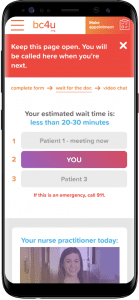As of April 22nd 2020, 42 states were under Stay At Home orders while clinics, hospitals and patients adapt to provide and receive care. The need for innovative Telehealth solutions is sky-rocketing. The US is experiencing a real time culture shift in the way healthcare is delivered. This is a shift to a “Telehealth first” approach, accelerating adoption by healthcare providers and acceptance on the part of patients that the first doctor-patient interaction might be a video visit.
This past week 303 Software launched Telehealth for BC4U, a program providing free health services to young people, ages 13 to 24. The coronavirus pandemic has amplified the urgency to bring this new system online. The 303 Software team is honored and excited to bring this service to life in collaboration with the team at BC4U.org!
Technology Highlight: Coronavirus and Beyond, Telehealth at Scale
Architected by our own CJ Reynolds, the new HIPAA compliant Telehealth system leverages WebRTC and peer-to-peer networking principles to negate the need for significant infrastructure under load. This means the software is built for scale, without having to add server resources. The 303 Software team also invented and implemented strategies around graceful degradation and pro-active network awareness so that a Telehealth visit can continue under poor network conditions. This strategy was originally aimed at the use case for serving rural communities with spotty internet, but when you have the entire household slurping bandwidth under Stay At Home orders, this feature can be just as critical in urban areas.
Coronavirus is causing the landscape of medicine to change rapidly. Innovation, both in technology and process improvement, often arises from adversity. The accelerated evolution brings up profound questions for healthcare delivery and costs. Will Telehealth acceptance persist in the long term? Could a “Telehealth first” approach reduce costs for patients and providers?
Forrester Research analysts estimate that coronavirus related Telehealth could exceed 900 Million visits this year. Even general medical Telehealth visits are now expected to top 200 Million, over a 500% increase from the previous expectation of 36 Million visits (1). Designing a scalable architecture from the ground up is paramount to success.
User Experience Highlight: This Waiting Room Rocks!
 It’s perfectly acceptable for a waiting room to be boring, expected even! It’s in the name. But-what-if-it-wasn’t?
It’s perfectly acceptable for a waiting room to be boring, expected even! It’s in the name. But-what-if-it-wasn’t?
Sarah Takahashi designed a waiting room that lets patients get to know the health provider they are about to meet with, and even learn some medical facts through videos along the way. This orients the young patient while reducing anxiety associated with having a healthcare visit. We may actually take the fun to the “next level” if health trivia or coronavirus themed Pong get upvoted on the product roadmap.
Patients can also see their place in line and estimated wait time. This is critical in preventing abandoned visits. If patients know where they stand, they are more willing to wait for their turn. And now we touch on another fundamental question bubbling up in the evolution of healthcare. Will the “On Demand” Telehealth model gain traction over the traditional “Scheduled Visit” pattern? Clearly there is room for both just as we have seen with the rise of brick and mortar “on demand” urgent care centers, but what will the new Telehealth culture mean for patients and providers? There may be an opportunity to decrease health care costs while improving patient satisfaction and outcomes through Telehealth adoption.
Most tectonic shifts in an industry begin with a major event that reframes the problem or alters the inputs, making change and even innovation inevitable. However uncomfortable, we are in that moment. Healthcare providers are adapting, Health Tech companies are inventing, but can we succeed in driving efficiency up and patient costs down, and do it at scale? Nothing is certain, but we will try.
Reference (1) : Coombs, Bertha. “Telehealth visits are booming as doctors and patients embrace distancing amid the coronavirus crisis” CNBC April, 4 2020 (https://www.cnbc.com/2020/04/03/telehealth-visits-could-top-1-billion-in-2020-amid-the-coronavirus-crisis.html)





